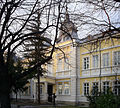Dobruja
Dobruja or Dobrudja (US: /ˈdoʊbrʊdʒə/;[1] Bulgarian: Добруджа, romanized: Dobrudzha or Dobrudža; Romanian: Dobrogea, pronounced [ˈdobrodʒe̯a] ⓘ or [doˈbrodʒe̯a]; Ukrainian: Задунав'я, romanized: Zadunav"ya; Turkish: Dobruca) is a geographical and historical region in Southeastern Europe that has been divided since the 19th century between the territories of Bulgaria and Romania. It is situated between the lower Danube River and the Black Sea, and includes the Danube Delta, Romanian coast, and the northernmost part of the Bulgarian coast. The territory of Dobruja is made up of Northern Dobruja, which is a part of Romania, and Southern Dobruja, which is a part of Bulgaria.
"Dobrudzha" redirects here. For the Bulgarian football team, see FC Dobrudzha Dobrich.
The territory of the Romanian region Dobrogea is organised as the counties of Constanța and Tulcea, with a combined area of 15,588 km2 (6,019 sq mi) and a population of slightly less than 900,000. Its main cities are Constanța, Tulcea, Medgidia and Mangalia. Dobrogea is represented by dolphins in the coat of arms of Romania.
The Bulgarian region Dobrudzha is divided among the administrative regions of Dobrich and Silistra; the following villages of Razgrad Province: Konevo, Rainino, Terter and Madrevo; and the village General Kantardzhievo (Varna). This section has a total area of 7,566 km2 (2,921 sq mi), with a combined population of some 310,000 people, the main towns being Dobrich and Silistra (regional seats).
Etymology[edit]
The most widespread opinion among scholars is that the origin of the term Dobruja is to be found in the Turkish rendition of the name of a 14th‑century Bulgarian ruler, despot Dobrotitsa.[3][4][5] It was common for the Turks to name countries after one of their early rulers (for example, nearby Moldavia was known as Bogdan Iflak by the Turks, named after Bogdan I). Other etymologies have been considered, but never gained widespread acceptance.
Abdolonyme Ubicini believed the name meant "good lands", derived from Slavic dobro ("good"), an opinion that was adopted by several 19th‑century scholars. This derivation appears to contrast with the usual 19th‑century description of Dobruja as a dry barren land; it has been explained as expressing the point of view of Ruthenes, who considered the Danube delta in the northern Dobruja as a significant improvement over the steppes to the North.[6] I. A. Nazarettean combines the Slavic word with the Tatar budjak ("corner"), thus proposing the etymology "good corner".
A version matching contemporaneous descriptions was suggested by Kanitz, who associated the name with the Bulgarian dobrice ("rocky and unproductive terrain").[7] According to Gheorghe I. Brătianu, the name is a Slavic derivation from the Turkic word Bordjan or Brudjars, which referred to the Turkic Proto-Bulgarians; this term was also used by Arabic writers.
One of the earliest documented uses of the name can be found in the Turkish Oghuz-name narrative, dated to the 15th century, where it appears as Dobruja-éli. The possessive suffix el-i indicated that the land was considered as belonging to Dobrotitsa ("دوبرجه" in the original Ottoman Turkish).[8] The loss of the final particle is not unusual in the Turkish world, a similar evolution being observed in the name of Aydın, originally Aydın-éli.[9] Another early use is in the 16th‑century Latin translation of Laonicus Chalcondyles' Histories, where the term Dobroditia is used for the original Greek "Dobrotitsa's country" (Δοβροτίκεω χώρα).[10] In the 17th century, the region was referred to in more accounts, with renditions such as Dobrucia, Dobrutcha, Dobrus, Dobruccia, Dobroudja, Dobrudscha, and others being used by foreign authors.[11]
Initially, the name meant just the steppe of the southern region, between the forests around Babadag in the north and the Silistra–Dobrich–Balchik line in the south.[12] Eventually, the term was extended to include the northern part and the Danube Delta.[13] In the 19th century, some authors used the name to refer just to the territory between the southernmost branch of the Danube (St. George) in the north and the Karasu Valley (nowadays the Danube-Black Sea Canal) in the south.[14]
History[edit]
Prehistory[edit]
The territory of Dobruja has been inhabited by humans since Middle and Upper Palaeolithic,[15] as the remains at Babadag, Slava Rusă and Enisala demonstrate. Paleolithic people made tools of silex and ate fruits, fish, and other hunted animals. In this period fire was discovered, and at its end, the bow with arrows and the boat sculpted from a trunk tree was invented. There were found tools in caves, inclusive Gura Dobrogei. In the Neolithic, the territory was occupied by members of the Hamangia culture (named after a village on the Dobrujan coast), Boian culture, and Karanovo V culture. At the end of the fifth millennium BC, under the influence of some Aegeo-Mediterranean tribes and cultures, the Gumelniţa culture appeared in the region. In the Eneolithic, populations migrating from the north of the Black Sea, of the Kurgan culture, mixed with the previous population, creating the Cernavodă I culture. Under Kurgan II influence, the Cernavodă II culture emerged. Through the combination of the Cernavodă I and Ezero culture, the Cernavodă III culture developed. The region had commercial contact with the Mediterranean world since the 14th century BC, as proven by a Mycenae a sword discovered at Medgidia,[16] but under the reserve demanded by lack of hard evidence in what concerns the provenience/manufacturer of such armours.
Demographic history[edit]
Ottoman era[edit]
On account of the Russo-Turkish War (1768–1774), one of the greatest migration events of the region occurred where an estimated 200,000 Tatars emigrated to the Dobruja region between 1770 and 1784. Whereas, a large group of Christians (likely Greeks and Slavs) moved the other direction into the Tatar's recently-loss region of Azov in 1778.[101]
The entire region of Dobruja has an area of around 23,100 km2 (8,919 sq mi) and a population of around 1.2 million, of which just over two-thirds of the former and nearly three-quarters of the latter lie in the Romanian part.
Major cities are Constanța, Tulcea, Medgidia and Mangalia in Romania, and Dobrich and Silistra in Bulgaria.





